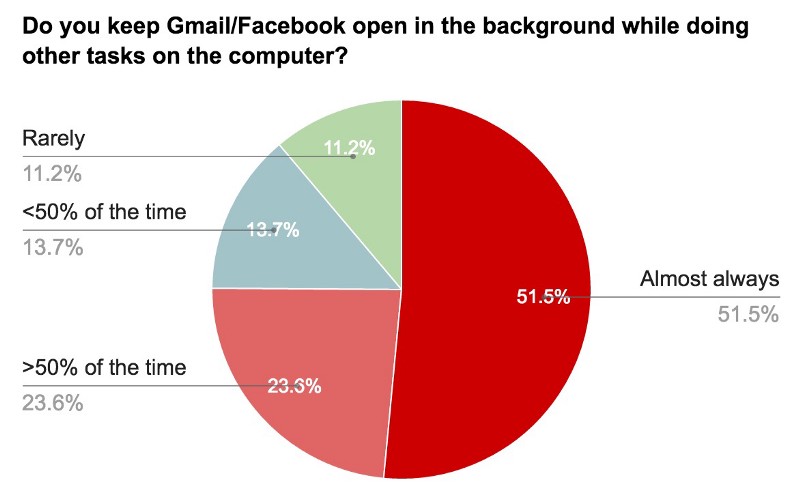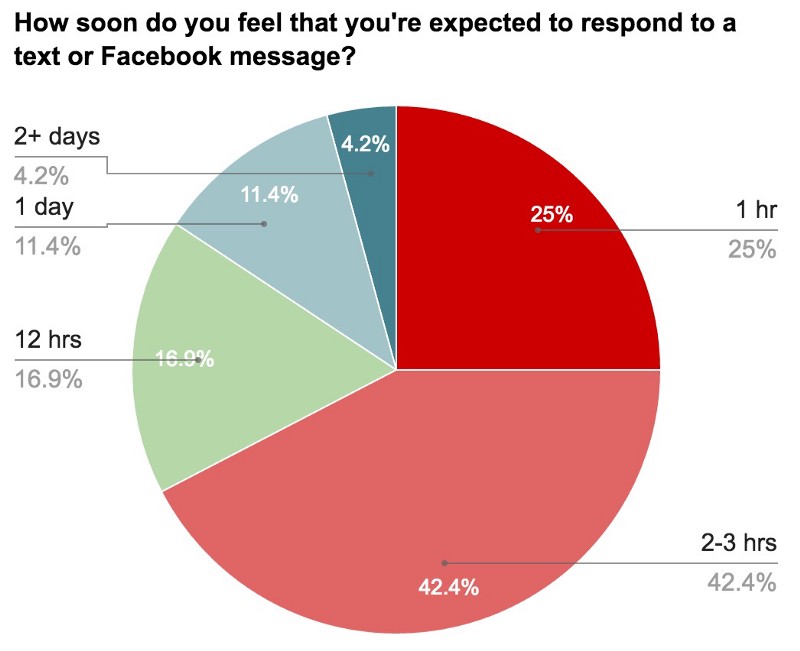Table of Contents
You’re a few pages into a Social Psychology reading when your phone buzzes. You respond to the meme that your friend texted you and refresh your email inbox while you’re at it. An hour passes, and you’ve barely made it past the first chapter.
This narrative is common at Stanford. Though it’s important to be engaged with messages and emails, digital notifications can be toxic to our productivity and well-being if we don’t make an active effort to manage them.
Our brains are wired to crave notifications. Opening a notification releases dopamine — the same chemical stimulated by drugs and sex — into our brains. Searching for more gratification, we keep checking our phones and refreshing Facebook. This behavior is toxic to our attention spans. Studies show that just hearing a phone buzz, even if we don’t actually look at the notification, measurably harms our ability to perform attention-demanding tasks.
Understanding a dense reading, making meaningful progress on a programming project, and succeeding at any intellectually demanding task all rely on our ability to focus. Victor Hugo made his servants confiscate his clothing so that he couldn’t leave his room until he finished writing; Maya Angelou worked in tiny hotel rooms with “all things taken off the walls”; and Albert Einstein developed a distraction index to measure and train his concentration span. Georgetown professor Cal Newport summarizes, “the ability to focus without distraction on a cognitively demanding task [allows] you to quickly master complicated information and produce better results in less time,” and it’s “becoming increasingly valuable in an increasingly complicated economy.”
Furthermore, notifications contribute to increased anxiety and stress levels. At Stanford, we dedicate countless resources, student groups, and conversations to stress and mental health. Yet nobody seems to talk about digital notifications as a significant and controllable cause of anxiety. For stressed Stanford students, receiving a notification — especially one we feel obligated to respond to — only adds to our cognitive load and increases anxiety.
Despite these findings, Stanford students seem tied to their devices. To gauge Stanford students’ engagement and attitude toward digital distractions, the Review conducted a survey last month. Our staff sent the survey to various mailing lists and Facebook groups across campus and received 234 responses (from 53 freshmen, 62 sophomores, 85 juniors, 29 seniors, and 5 other).
These results could be slightly biased; more distracted students may be more likely to click on the survey. However, they do suggest that Stanford students often allow themselves to be distracted by digital notifications while working on other tasks. 75% of surveyed students reported keeping Gmail and/or Facebook open in the background for over half the time they spend on the computer; 51% keep them open “almost always.” 60% of respondents also keep their phones on vibrate or full volume when not in class. But more often than not, Stanford students are allowing distractions to stay within easy reach.
One cause for our tolerance for distraction could be that students feel obligated to be highly responsive to messages. 25% of surveyed students felt that they were expected to respond to a text or Facebook message within an hour. Another 42% feel obligated to respond within 2–3 hours, and only 15% expressed that it was acceptable to wait over 12 hours to respond.


To investigate social pressures that may contribute to these expectations, we asked students (in an optional question) whether they view message response times to be indicative of how much someone cares about them. 80 of the 108 respondents wrote that response times are at least somewhat indicative of how much someone values them. Many students also expressed that they expect faster response times from potential or current romantic partners; one even wrote that they would “never” date someone who didn’t respond to messages within 10 minutes.
Though most people noted that they interpret response times differently based on the person and situation, it seems unreasonable to ask individuals to demonstrate their care by sacrificing their ability to concentrate. We risk trivializing our relationships if we measure them by response time rather than words or actions.
Nonetheless, these social expectations can translate into a significant commitment when students receive many messages every day. On average, respondents counted 12 active instant messaging threads in the last 24 hours. (This number may even be lower than usual because the survey was distributed the week before Dead Week, during which students are generally busier — and may spend less online — than usual.) Moreover, 60% engage in real-time digital conversations at least once a day (where all parties respond almost instantly for at least 5–10 minutes).
However, students generally seem fine with their current level of engagement with notifications. 46% of surveyed students reported being “fine with [their] current level of engagement”; another 37% indicated that, although they feel that they spend too much time and attention on messages, it’s okay for the most part. Only 10% feel often overwhelmed by the number of messages and notifications they receive.
Students seem to adopt these complacent attitudes because we accept that digital engagement is critical to social and professional success. In an optional section of the survey, 99 respondents overwhelmingly expressed that staying digitally connected is vital to their social lives and careers. Although several respondents noted that digital engagement is detrimental to their academic success, only 5% expressed that it wasn’t at all important to be connected. As young, ambitious students bombarded with advice to “expand our networks,” we naturally feel pressure to be constantly responsive online. But this pressure too often leads us to justify our weak, unfocused work habits in the name of necessity.
On the bright side, many students do at least try to manage digital distractions. In an optional question, 88 students described their strategies, almost all of which fell into three categories: turning off notifications, devices, and/or distracting tabs; setting aside specific times for checking email or social media; and using apps or browser extensions to block distracting sites. One determined student even quit texting altogether. However, their success may be limited: 47% of those who described using a strategy still “almost always” keep Facebook/Gmail open in the background, and 57% keep their phones on vibrate or full volume most of the time.
At Stanford, we commonly complain that we’re stressed about all of our obligations and that we never have enough time to do everything we want. We can easily improve on both fronts by taking active control of our digital lives and attention spans. Rather than giving notifications the power to take away our focus at any moment, we could decide to check our phones at the end of every hour or two of focused work, for example. Though it may take some self-discipline at first, we’ll grow accustomed to checking for notifications less often if we keep up the habit.
Recognizing the importance of digital engagement shouldn’t be an excuse for us to turn a blind eye to its detrimental effects. As 2017 begins, consider how a mindful use of technology in the upcoming year could make you happy and productive.





